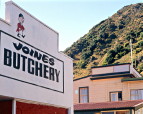The first Paekākāriki butcher shop opened somewhere between 1910 and 1915. The shop, at 6 Beach Road, was located next to the building that used to be the Post Office. At first, the shop was housed in two sheds. These may have been relocated to the site or may have been purpose built. This first butcher shop was set up by Mr Deacon, who also had another four shops between Wellington and Levin, each with its own manager. Mr Deacon eventually tired of running these butcheries and offered to sell them to their managers. George Joines, the manager of the Paekākāriki butchery, took up the offer and bought the business in the late 1920s or early 1930s. George’s son Ray, who had completed his apprenticeship in Wellington, joined his father along with Jack White. Ray eventually took over the business from his father. Darcy Jarvis was the first apprentice butcher in the village, when he joined the butchery in the 1960s. During his time, it was a busy enterprise with four staff.
Darcy was inspired to join the butchery after enjoying regular chats with its staff when he ‘was a lad’. There was a bake house directly behind the butcher shop (between it and the current bowling green) that Darcy’s father had taken over after World War II. Darcy recalls regularly accompanying his parents to the bake house in the early mornings and spending much of his time with the team next door. In those days, the bake house made bread and pies, and made and decorated cakes (including wedding cakes). It made deliveries as far south as Tawa. One of the main customers, especially for the pies, was the Paekākāriki tearooms where the current Deli café is located.
George Joines opened another butchers shop at 22a Te Miti Street, where his son Ray lived. He’d got wind of the possibility that a large Wellington enterprise might move into the village as it already delivered to the area once a week. He decided his expansion would stop the competition. By this stage, the village had grown substantially, both because of the number of rail workers and because of the new housing built north of Te Miti Street in the 1960s. Also, families tended to be large – Darcy reported that it wasn’t unusual for families to include 10 children.
The Beach Road shop was busy. As business grew, the original two sheds were joined together and then expanded some time before the 1960s. As was typical of butcheries of the day, there was sawdust on the floor in the shop and straw in the cool room to soak up blood. A couple of butcher blocks and a counter completed the shop fittings.
The butcher made deliveries three times a week in the 1950s and 1960s – Tuesday, Thursday, and Saturday. Making these deliveries and, at the same time, catching up on village gossip was one of the jobs of the first apprentice, Darcy reports. He describes having ‘a good yack and a glass of cordial’ with various customers along the way. The telephone exchange, based on party lines, helped these customers (and then the butchers) spread village news and gossip. The woman managing the exchange may also have been a good source of village gossip.
The Beach Road shop opened five days a week and closed on Wednesday and Sunday. The Saturday opening, and delivery, reflects the holiday resort character of the village. Many of the houses in the village were holiday houses for Wellingtonians who arrived for the weekend wanting supplies. The local camping ground, which was always full in the summer, also attracted visitors. Holiday makers’ and bach owners’ spending was important to the butcher and to local village businesses, with most opening for Saturday trading. Presumably, businesses had special licences to trade, in a similar way to New Brighton in Christchurch, as weekend trading was still very unusual in mid-century New Zealand.
The butcher was one of many shops and other businesses on Beach Road during a time when most people shopped locally (before the opening of the Coastland Mall in the 1970s). For instance, in the 1950s and 60s, the south side of Beach Road had a tobacconist, a barber, a lottery ticket outlet, a taxi business, a clothes factory, a false teeth manufacturer/fitter, a TAB, a fish and chip shop, a bank, a grocery shop and greengrocer, and doctors’ rooms. On the north side there was the Post Office, the butcher, a chemist, a drapery, another bank, and the hotel. Elsewhere in the village, for instance on Te Miti Street and Tilley Road, there was another butcher, along with three grocers, two bakeries, and a book shop.
The butcher finally closed down as business had dwindled, with local people increasingly doing their weekly shopping at the new Coastlands mall in Paraparaumu.
